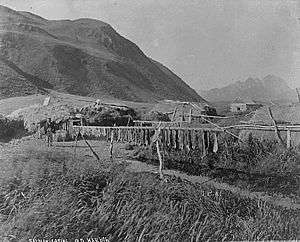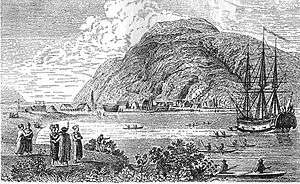Awa'uq Massacre
| Awa'uq Massacre | |||
|---|---|---|---|
| Part of the Russian colonization of the Americas | |||
|
Grigory Shelikhov's settlement is depicted in this 1802 lithograph. Three Saints was founded in 1784 just across the strait from Sitkalidak Island. | |||
| Date | 14 August 1784 | ||
| Location |
Sitkalidak Island, Alaska, Russian America 57°06′22″N 153°05′00″W / 57.10604°N 153.0832814°WCoordinates: 57°06′22″N 153°05′00″W / 57.10604°N 153.0832814°W | ||
| Parties to the civil conflict | |||
| |||
| Lead figures | |||
| |||
| Number | |||
| |||
| Casualties | |||
| |||
The Awa'uq Massacre[3][4] or Refuge Rock Massacre,[4] or the Wounded Knee of Alaska,[5] was an attack and massacre by Russian fur trader Grigory Shelikhov and 130 Russian armed men and cannoneers of Shelikhov-Golikov Company against the Qik’rtarmiut Sugpiat tribe of Koniag Alutiiq (Sugpiaq) people of Kodiak Island in 1784 in Russian-controlled Alaska.
Massacre
It occurred on the secluded stack island Refuge Rock (Awa'uq in Alutiiq language, approximate meaning 'where one becomes numb'[6]) of Partition Cove on Sitkalidak Island, near and across Old Harbor, in the Kodiak Archipelago, Alaska.[7] The Russian promyshlennikis slaughtered 500[8] men, women and children on Refuge Rock, though some sources state the number was 2,000,[1] or between 2,500–3,000.[2][9] Following the attack of Awa'uq, Shelikhov claims to have captured over 1,000 people, detaining 400 as hostages.[1] There were no Russian casualties.[2] This massacre was an isolated incident, and the Alutiiq were completely subjugated by Russian traders thereafter.[10] One interpreter, Qaspeq (literally: "kuspuk"), was an Alutiiq (Sugpiaq) who had been taken as a war captive from Kodiak as a child and raised in servitude in the Aleutians. Qaspeq had once betrayed the location of a refuge island just offshore of Unalaska Island.[11]
Aftermath
The years 1784–1818, called the "darkest period of Sugpiaq history," ended with a change in the management of the Russian-American Company.[12]
Over a half century later, an old Sugpiaq (Koniag Alutiiq) man, Arsenti Aminak, reported his own recollections of the same events to a Finnish naturalist and ethnographer Henrik Johan Holmberg (sometimes known as Heinrich Johann) (1818–1864) collecting data for the Russian governor of Alaska.[13] Arsenti Aminak (his memory of Russian conquest at Awa’uq that Aminak survived as a young boy[14]) said:
The Russians went to the settlement and carried out a terrible blood bath. Only a few [people] were able to flee to Angyahtalek in baidarkas; 300 Koniags were shot by the Russians. This happened in April. When our people revisited the place in the summer the stench of the corpses lying on the shore polluted the air so badly that none could stay there, and since then the island has been uninhabited. After this every chief had to surrender his children as hostages; I was saved only by my father's begging and many sea otter pelts.— Arsenti Aminak, [15]
| year | Aleutian Islands (= Aleut ~ Unangan) | Kodiak Island, Cook Inlet, Prince William Sound (= Alutiiq ~ Sugpiaq) | Kodiak Island only (= Koniag Alutiiq) | Cook Inlet, Prince William Sound only (= Chugach Sugpiaq) |
|---|---|---|---|---|
| 1741 | |
|||
| 1784 | |
|||
| 1791 | |
|
| |
| 1804 | |
|||
| 1806 | |
|||
| 1813 | |
|||
| 1817 | |
| ||
| 1821 | |
|||
| 1834 | |
|||
In 1827 collection of yasak (ясак) tax banned by Catherine the Great.[13]
| 1797-1821 | Average/yr 1797-1821 | 1821-1842 | Average/yr 1821-1842 | |
|---|---|---|---|---|
| Sea otters | 72,894 | 2,916 | 25,416 | 1,210 |
| Beavers | 34,546 | 1,382 | 162,034 | 7,716 |
| River otters | 14,969 | 599 | 29,442 | 1,402 |
| Fur seals | 1,232,374 | 49,295 | 458,502 | 21,833 |
| Foxes | 102,134 | 4,085 | 90,322 | 4,301 |
| Sables | 17,298 | 692 | 15,666 | 746 |
| Wolverines | 1,151 | 46 | 1,564 | 74 |
| Lynx | 1,389 | 56 | 4,253 | 203 |
| Minks | 4,802 | 192 | 15,481 | 737 |
| Polar foxes | 40,596 | 1,624 | 69,352 | 3,302 |
| Wolves | 121 | 5 | 201 | 10 |
| Bears | 1,602 | 64 | 5,355 | 255 |
| Sea lions | 27 | 1 | Ø | 0 |
| Walrus tusks (poods = 36 pounds) | 1,616 | 65 | 6,501 | 310 |
| Baleen (poods = 36 pounds) | 1,173 | 47 | 3,455 | 165 |

References
- 1 2 3 4 Ben Fitzhugh (2003), The Evolution of Complex Hunter-Gatherers: archaeological evidence from the North Pacific, Kluwer Academic/Plenum Publishers, New York, 2003
- 1 2 3 4 The Afognak Alutiiq People: Our History and Culture, Alutiiq, a wholly owned subdiary of Afognak Native Corporation, July 2008
- ↑ Sven Haakanson, Jr. (2010), Written Voices Become History. In Being and Becoming Indigenous Archaeologists. George Nicholas (editor). Left Coast press, Inc., 2010
- 1 2 Afognak Village Timeline
- ↑ John Enders (1992), Archaeologist May Have Found Site Of Alaska Massacre, The Seattle Times, Sunday, August 16, 1992
- ↑ Finding Refuge, PBS, NETA, first release 3 Oct. 2015.
- ↑ Gordon L. Pullar, Ethnographie historique des villages sugpiat de Kodiak à la fin du XIXe siècle. In Giinaquq = Like a Face : Sugpiaq masks of the Kodiak archipelago (editors: Sven Haakanson Jr. and Amy Steffian), 2009 University of Alaska Press. {En 1784, peu après la prise de contrôle de l'île de Kodiak par les Russes qui avait entraîné le massacre de centaines de Sugpiat à Awa'uq (Refuge Rock), le marchand russe Grigorii Shelikhov prit en otage les enfants de reponsables sugpiaq pour les avoir sous son controle er, ainsi, contrôler tout leur peuple.}
- ↑ Korry Keeker, What it means to be Alutiiq / State museum exhibit examines Kodiak-area Native culture, Friday, April 25, 2003
- ↑ Reuters : Grounded Shell Oil Rig Off Alaska Coast Still Has No Flooding Or Sheening, Despite Damage. By Yereth Rosen (January 3, 2013, Anchorage)
- ↑ Aron L. Crowell (2001), Looking Both Ways, Heritage and Identity of the Alutiiq People. Fairbanks: University of Alaska Press, 2001
- ↑ Richard A. Knecht, Sven Haakanson, and Shawn Dickson (2002). "Awa'uq: discovery and excavation of an 18th century Alutiiq refuge rock in the Kodiak Archipelago Awa'uq: discovery and excavation of an 18th century Alutiiq refuge rock in the Kodiak Archipelago". In To the Aleutians and Beyond:, Bruno Frohlich, Albert S. Harper, and Rolf Gilberg, editors, Pp. 177-191. Publications of the National Museum Ethnographical Series, Vol. 20. Department of Ethnography, National Museum of Denmark, Copenhagen. the Anthropology of William S. Laughlin.
- ↑ Lydia T. Black (1992), "The Russian Conquest of Kodiak." In: Anthropological Papers of the University of Alaska. Vol. 24, Numbers 1-2. Fall. Department of Anthropology, University of Alaska Fairbanks
- 1 2 Miller, Gwenn A. (2010). Kodiak Kreol: Communities of Empire in Early Russian America. Ithaca, NY: Cornell University Press. ISBN 978-0-8014-4642-9.
- ↑ Drabek, Alisha Susana 2012. Liitukut Sugpiat'stun (we are learning how to be real people): Exploring Kodiak Alutiiq literature through core values. A thesis Presented to the Faculty of the University of Alaska Fairbanks in Partial Fulfillment of the Requirements for the Degree of Doctor of Philosophy. Fairbanks, Alaska, December 2012.
- ↑ Heinrich J. Holmberg (1985), Holmberg's Ethnographic Sketches. Translated by Marvin W. Falk, edited by Fritz, Limestone Press, Fairbanks (p. 59)
- 1 2 Russian American Reader
